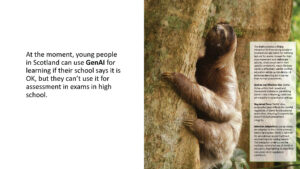By Judy Robertson
In our previous post, we introduced our Exploring Generative AI in Education picture book, and the visual map of the AI landscape in Scotland. This post is about the messages in the picture book and why we chose those animals to represent the messages.
I wrote the text for the picture book. I wanted to put across key messages about AI, and the issues which our interviewees were talking about as clearly as possible so that children and teachers would understand it. Although it’s short, it was hard to write! I used the picture book All Dogs Have ADHD as inspiration because the author manages to express such a lot about a complex topic with such simple words, and the pictures are a great memory aid. It occurred to me that a lot of children (and adults!) might be aware of Generative AI tools such as ChatGPT from seeing them in the news or playing around with apps, but they might not know some basic facts about how AI works and what it can and can’t do.
For example, after explaining that GenAI tools don’t always produce reliable output, I wanted to explain that AI doesn’t intentionally lie (see below). It simply doesn’t know what is true and what is not because it only has access to the Internet, which is chock full of lies. Elspeth and ChatGPT had various discussions about which animal could illustrate my sentence, with Elspeth patiently prompting it to explain why it chose each metaphorical animal. In the first version, we had a mimic octopus to illustrate this statement but Laura the biologist objected to this on the grounds that apparently you don’t get octopii in the jungle. We considered a parrot, but the parrot was already working hard to explain how language generation works so we went for an owl butterfly. If you’re wondering about the metaphor, here is ChatGPT’s typically glib explanation:
“An owl butterfly that uses camouflage serves as a metaphor for a GenAI program that provides untrue information without the intent to deceive. These insects camouflage instinctively, not to deliberately mislead but as an evolutionary survival strategy.”
Rereading that now, I am slightly troubled by the last bit. Is ChatGPT telling us it makes stuff up as an evolutionary survival strategy we haven’t figured out yet?*

One of the themes which emerged from the interviews is that there is a mismatch in pace between how quickly AI technology is advancing, and how slowly the education system is responding. This sounds critical, but it’s not. Tech companies might be proud of moving fast and breaking things, but educators and policymakers can’t risk breaking young people’s futures. As a specific example, I wanted to reinforce to young people that they can’t use GenAI for formal assessment just now in Scotland (see below for the relevant page in the picture book). This is the current policy of the SQA, but they are actively reviewing it. They are taking the time to think carefully about how AI could be used in learning and assessment so they can get the policy right in the medium/long term. This is the right call, in my view. So, we have a sloth picture to remind us that there is a need for slow, purposeful deliberation even in a fast-moving AI jungle. And who doesn’t love sloths?

It has been fun to work on this project. I’m a computer scientist, Elspeth is a designer, Laura is a biologist and ChatGPT is a big bag of maths. It has been intriguing to learn from each other and, between us, produce something which none of us could have made alone. The richness of the jungle metaphor – suggested by our interviewees – has opened up a fresh way to look at AI. The strangeness and wonder of animal behaviour in the natural world provoke new perspectives about what AI could be like and how we want to interact with it.
*Nope.


